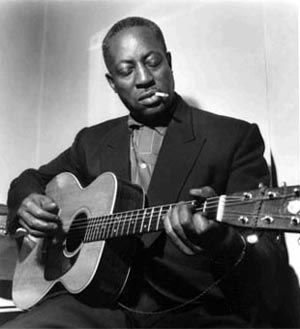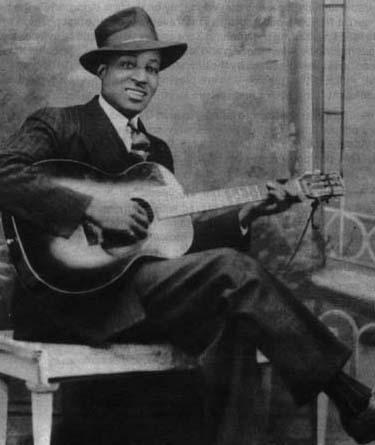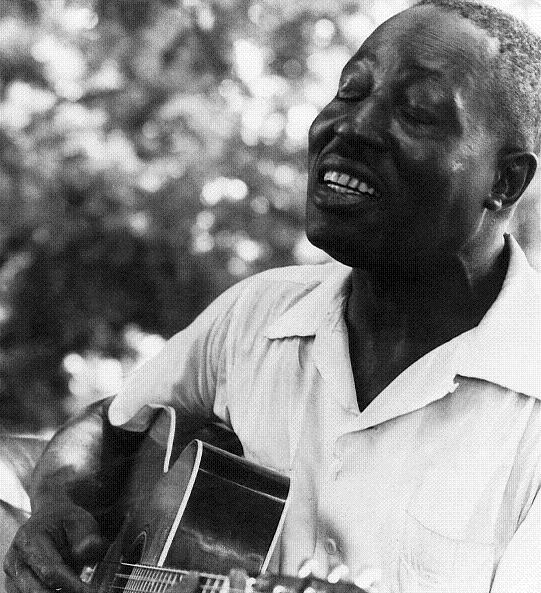<Back to Index>
- Physicist William Thomson, 1st Baron Kelvin, 1824
- Bluesman Big Bill Broonzy, 1898
- 8th Prime Minister of Canada Sir Robert Laird Borden, 1854


Big Bill Broonzy (26 June 1898 – 14 August 1958) was a prolific African American blues singer, songwriter and guitarist. His career began in the 1920s when he played Country blues to mostly black audiences. Through the ‘30s and ‘40s he successfully navigated a transition in style to a more urban blues
sound popular with white audiences. In the 1950s a return to his
traditional folk-blues roots made him one of the leading figures of the
emerging American folk music revival and
an international star. His long and varied career marks him as one of
the key figures in the development of blues music in the 20th century. Broonzy copyrighted more than 300 songs during his lifetime, including both adaptations of traditional folk songs and
original blues songs. As a blues composer, he was unique in that his
compositions reflected the many vantage points of his rural-to-urban
experiences. He was born William Lee Conley Broonzy in Bolivar County, Mississippi,
one of Frank Broonzy and Mittie Belcher's 17 children. Broonzy claimed
he was born in 1893 and many sources report that year, but after his
death his twin sister produced a birth certificate giving it as 1898,
the currently accepted date. Soon after his birth the family moved to Pine Bluff, Arkansas, where Bill spent most of his youth. He began playing music at an early age. At the age of 10 he made himself a fiddle from a cigar box and learned how to play spirituals and
folk songs from his uncle, Jerry Belcher. He and a friend named Louis
Carter, who played a homemade guitar, began performing at social and
church functions. These
early performances included playing at "two-stages", picnics where
whites danced on one side of the stage and blacks on the other. In 1915, 17-year-old Broonzy was married and working his own land as a sharecropper. He had decided to give up the fiddle and become a preacher. There is a story that he was offered $50 and a new violin if
he would play four days at a local venue. Before he could respond to
the offer, his wife took the money and spent it, so he had to play. In
1916 his crop and stock were wiped out by drought. Broonzy went to work in the local coal mine until he was drafted into the Army in 1917. Broonzy served two years in Europe during the first world war. After his discharge from the Army in 1919, Broonzy returned for a short time to Arkansas and played clubs in the Little Rock area. As prospects were bleak for a young black man in the south, Broonzy moved north to Chicago in 1920 in search of opportunity. After arriving in Chicago, Broonzy made the switch to guitar. He learned guitar from minstrel and medicine show veteran Papa Charlie Jackson, who began recording for Paramount Records in 1924. Through the 1920s Broonzy worked a string of odd jobs, including Pullman porter, cook, foundry worker and custodian, to supplement his income, but his main interest was music. He played regularly at rent parties and
social gatherings, steadily improving his guitar playing. During this
time he wrote one of his signature tunes, a solo guitar piece called
"Saturday Night Rub". Thanks to his association with Jackson, Broonzy was able to get an audition with Paramount executive J. Mayo Williams.
His initial test recordings, made with his friend John Thomas on
vocals, were rejected, but Broonzy persisted, and his second try, a few
months later, was more successful. His first record, "Big Bill's Blues"
backed with "House Rent Stomp", credited to "Big Bill and Thomps"
(Paramount 12656), was released in 1927. Although the recording was not
well-received, Paramount retained their new talent and the next few
years saw more releases by "Big Bill and Thomps". The records continued
to sell poorly. Reviewers considered his style immature and derivative. In
1930 Paramount for the first time used Broonzy's full name on a
recording, "Station Blues" — albeit misspelled as "Big Bill Broomsley".
Record sales continued to be poor, and Broonzy was working at a grocery
store. Broonzy was picked up by Lester Melrose, who produced acts for various labels including Champion and Gennett Records. He recorded several sides which were released in the spring of 1931 under the name "Big Bill Johnson". In March 1932 he traveled to New York City and began recording for the American Record Corporation on their line of less expensive labels (Melotone, Perfect Records, et al.). These recordings sold better and Broonzy began to become better known. Back in Chicago he was working regularly in South Side clubs, and even toured with Memphis Minnie. In 1934 Broonzy moved to Bluebird Records and
began recording with pianist Bob "Black Bob" Call. His fortunes soon
improved. With Call his music was evolving to a stronger R&B sound,
and his singing sounded more assured and personal. In 1937, he began
playing with pianist Josh Althiemer, recording and performing using a
small instrumental group, including "traps" (drums) and Double bass as well as one or more melody instruments (horns and/or harmonica). In March 1938 he began recording for Vocalion Records. Broonzy's reputation grew and in 1938 he was asked to fill in for the recently deceased Robert Johnson at the John H. Hammond-produced From Spirituals to Swing concert at Carnegie Hall. He also appeared in the 1939 concert at the same venue. Broonzy's
own recorded output through the 1930s only partially reflects his
importance to the Chicago blues scene. His half-brother, Washboard Sam, and close friends, Jazz Gillum, and Tampa Red,
also recorded for Bluebird. Broonzy was credited as composer on many of
their most popular recordings of that time. He reportedly played guitar
on most of Washboard Sam's tracks. Due to his exclusive arrangements
with his own record label, Broonzy was always careful to have his name
only appear on these artists' records as "composer".
Despite
his successes, Broonzy's audiences were still small in the 1940s, and
he again needed to work outside music to make ends meet. He supported
himself working as a cook, porter, molder, piano mover, and whatever
other work he could find. He still continued to record, moving to Columbia Records in 1945. One of his best-known songs, Charlie Segar's Key to the Highway, appeared at this time. When the second American Federation of Musicians strike ended in 1948, Broonzy was picked up by the Mercury label, for whom he made a handful of records. At
the start of the 1950s, Broonzy's career seemed to be at a standstill,
and he considered giving up the music business. But he had become part
of a touring folk music revue formed by Win Stracke called I Come for to Sing, which also included Studs Terkel and Lawrence Lane. Terkel called him the key figure in this group. The group had some success thanks to the emerging folk revival movement. The exposure made it possible for Broonzy to tour Europe in 1951. In
Europe, Broonzy was greeted with standing ovations and critical praise
wherever he played. The tour marked a turning point in his fortunes,
and when he returned to the United States he was a featured act with
many prominent folk artists such as Pete Seeger, Sonny Terry and Brownie McGhee, and Leadbelly.
From 1953 on his financial position became more secure and he was able
to live quite well on his music earnings. Broonzy returned to his solo folk-blues roots, and travelled and recorded extensively. While in Holland, Broonzy met and fell in love with a Dutch girl, Pim van Isveldt. Together they had a child named Michael who still lives in Amsterdam. In 1953, Dr. Vera (King) Morkovin and Studs Terkel took Broonzy to Circle Pines Center, a cooperative year-round camp in Hastings, Michigan, where he was employed as the summer camp cook. He worked there in the summer from '53-'56. On July 4, 1954, Pete Seeger travelled
to Circle Pines and gave a concert with Bill on the farmhouse lawn,
which was recorded by Seeger for the new fine arts radio station in
Chicago, WFMT-FM. In 1955, with the assistance of Belgian writer Yannick Bruynoghe, Broonzy published his autobiography, entitled Big Bill Blues. He toured worldwide to Africa, South America, the Pacific region and across Europe into early 1956. In 1957 Broonzy was one of the founding faculty members of the Old Town School of Folk Music. At the school's opening night on December 1, he taught a class his song "The Glory of Love". By 1958 Broonzy was suffering from the effects of throat cancer. He died August 15, 1958, and is buried in Lincoln Cemetery, Blue Island, Illinois. Broonzy's own influences included the folk music, spirituals, work songs, ragtime music, hokum and country blues he heard growing up, and the styles of his contemporaries, including Jimmie Rodgers, Blind Blake, Son House, and Blind Lemon Jefferson. Broonzy combined all these influences into his own style of the blues that foreshadowed the post-war Chicago bluessound, later refined and popularized by artists such as Muddy Waters and Willie Dixon. Although he had been a pioneer of the Chicago blues style
and had employed electric instruments as early as 1942, his new, white
audiences wanted to hear him playing his earliest songs accompanied
only by his own acoustic guitar, since this was considered to be more "authentic". A
considerable part of his early ARC/CBS recordings have been reissued in
anthology collections by CBS-Sony, and other earlier recordings have
been collected on blues reissue labels, as have his later European and
Chicago recordings of the 1950s. The Smithsonian's Folkways Records has also released several albums featuring Big Bill Broonzy. Broonzy was an acoustic guitar player, inspired Muddy Waters, Memphis Slim, Ray Davies, John Renbourn, Rory Gallagher, and Ben Taylor. In Q Magazine (September 2007) it is reported that Ronnie Wood of The Rolling Stones claims
that Bill Broonzy's track, "Guitar Shuffle", is his favorite guitar
music. Wood said, "It was one of the first tracks I learnt to play, but
even to this day I can't play it exactly right." During the benediction at the 2009 inauguration ceremony of President Barack Obama, the civil rights leader Rev. Dr. Joseph Lowery paraphrased Broonzy's song "Black, Brown and White Blues". Broonzy recorded over 350 compositions. He was inducted into the Gennett Records Walk of Fame in Richmond, Indiana, in 2007.

